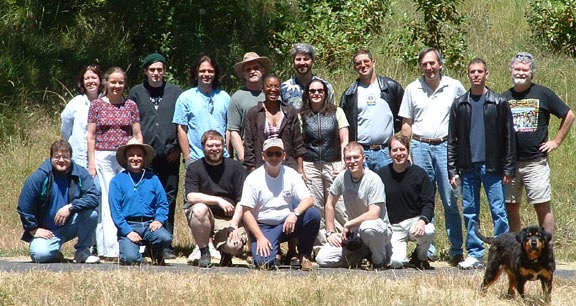Jun 26 - 27, 2004
After a two-year hiatus, Phrontisterion V came roaring back with what was probably the best conference ever. The discussions were intense yet not argumentative or confrontational. People brought many points of view and disagreed on many issues, but the disagreements were regarded by all as fascinating new angles on the problems. The result was especially satisfying for me; I felt that I learned from these discussions.
I’ll not present a synopsis of the conference, because the attendees are preparing one. We agreed to set up a blog on interactive storytelling to which all will contribute their observations about the conference. I shall link to that blog when it is up and running, which should be well before the end of the month. In the meantime, I offer a few observations of my own.
The most striking issue, for me, was the skepticism some people expressed regarding the marketability of interactive storytelling. While most of the attendees accepted as a matter of vision that interactive storytelling would someday become a huge entertainment market, a few had the temerity to question that vision. Indeed, we have no evidence that it will in fact appeal to anybody at all. But the absence of evidence is not, in my opinion, of significance here. It should be obvious to anybody how flawed it is to argue that no market could exist because no market now exists. The appropriate conclusion to draw is that we have no direct evidence that interactive storytelling will catch on, and no direct evidence that it won’t. Ergo, we must rely on indirect evidence interpreted carefully.
The best case in this regard has been made by Laura Mixon. She listed four major entertainment fields: books, movies, television, and games. Then she established a number of criteria by which these might be rated: "storiness", spectacle, and interactivity are all I remember. She then rated each medium in each of the criteria as high, moderate, or low. Next, she compiled the overall market sales in the USA of each of the media. Lastly, she listed interactive storytelling and rated it in each of the evaluation criteria. The result is striking: interactive storytelling shows up as strong in the areas that seem to be most important to high sales. My pitiful rendering of her work does it no justice; you should consult her own explanation at this link.
My own argument is a cruder version of hers. I begin with the observation that electronic games are a financially successful entertainment medium, earning gross revenues of about $20 billion a year in the USA. I next claim that the element of games that underlies that success is interactivity. Everybody likes to point to the graphics, but they confuse a differentiating element from a motivating element. Good graphics can make a game sell better than its competitor, but graphics don’t motivate people to buy games. People were spending billions on games when the graphics were little colored squares. It’s the interactivity that makes games fun, and interactivity is the only advantage that games have over other media, such as movies, television, and books.
I therefore conclude that interactivity alone is worth about $20 billion a year in gross revenues. But the crucial element in the other entertainment media is storytelling, and those media earn perhaps $80 billion a year. Books, movies, and television all tell stories. Games don’t. So the question becomes, if we could combine the key success factor in movies, television, and books with the key success factor in games, what kind of market would we have? I’d guess that it would be at least $20 billion a year, and could well reach $50 billion a year. And that combination is exactly what interactive storytelling delivers.
The conference was structured around the theme "books on interactive storytelling". The three books were Andrew Glassner’s "Interactive Storytelling", Lee Sheldon’s "Character Development and Storytelling for Games" and my own "Chris Crawford on Interactive Storytelling". However, we spent most of our time discussing my book. This wasn’t due to any inherant superiority in my book: it was because I mailed out a manuscript to every participant three weeks before the conference. Lee’s book came out three days before the conference. Few people had read Andrew Glassner’s book. So the discussion centered on my favorite subject: me.
We went through the book chapter by chapter, but the first three chapters occupied us for the entire morning of the first day, so we were forced to take a more cursory approach to the later chapters. The length of the discussion I cannot fairly attribute to the value of the book. After all, if the book really were that good, there would have been no discussion at all, because it would have answered all the questions. Instead, the material in the book triggered intense discussion on all manner of related topics.
There was little direct criticism of the book, as I recall. Nobody tore into the book to denounce its lies, obscurities, and errors. The discussion centered on extensions of the concepts in the book and discussions of some of the fundamental assumptions underlying the book. There was some disagreement with my pessimistic assessment of the likelihood that games will ever evolve effective means of interactive storytelling. The group also indulged me a 20-minute lecture on the linguistic concepts that underlie some of my technology.
Several other attendees have prepared their own reports on Phrontisterion 5:
Rick Smith
Joseph Breitreiter
Kyle Pierce
Barbara Grueter
Gordon Walton
Larry Mellon
Christopher James
The attendees of Phrontisterion 5, June 26-27 2004
From top left:
Jessica Josephson, Barbara Grueter, Joseph Breitreiter, Brian Magerko, Larry Mellon,Jeff Rawlings, John Sutherland, Kyle Pierce, Kevin Gliner, Thom Gillespie
Standing center:
Michelle Mellon, Ellie Sari
Kneeling front:
Tim Emmerich, Chris Crawford, Rick Smith, Gordon Walton, Christopher James, Jonathon Sari
Front:
Moose the dog
Not shown:
Laura Mixon
